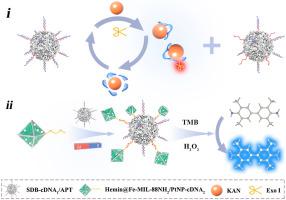Analytica Chimica Acta ( IF 5.7 ) Pub Date : 2022-07-19 , DOI: 10.1016/j.aca.2022.340178 Guanghua Li 1 , Sha Liu 2 , Yapeng Huo 3 , Huanying Zhou 2 , Sen Li 2 , Xiaohui Lin 4 , Weijun Kang 5 , Shuang Li 2 , Zhixian Gao 2

|
Kanamycin (KAN) residues in animal-derived food can cause serious threats to human health. Herein, a colorimetric aptasensor was described using “three-in-one” nanohybrids (hemin@Fe-MIL-88NH2/PtNP) as synergistic nanozymes assisted with the exonuclease I (Exo I) signal amplification for the ultrasensitive detection of KAN. In the presence of KAN and Exo I, the KAN aptamer (APT) was specifically bound to KAN, and the remaining APT complementary strand (cDNA1) captured hemin@Fe-MIL-88NH2/PtNP labeled with the cDNA1 complementary strand (cDNA2). Due to the synergistic effect of hemin, Fe-MIL-88NH2 and platinum nanoparticles (PtNPs), hemin@Fe-MIL-88NH2/PtNP exhibited superior catalytic performance and could efficiently catalyze the 3,3′,5,5′-tetramethylbenzidine (TMB)-H2O2 system for signal development. Moreover, Exo I could digest APT and release KAN into a new cycle for signal amplification. Based on multiple signal amplification effects, our proposed aptasensor achieved a wide detection range from 0.01 to 100 ng mL−1 with a low detection limit of 2 pg mL−1. This assay also successfully detected KAN-added milk and shrimp samples with added recovery ranges of 93.58%–106.08% and relative standard deviations (RSDs) of 2.20%–5.50%. The aptasensor enabled ultrasensitive, specific, and fast detection of KAN, and exhibited promising applications in the efficient detection of food pollutants.
中文翻译:

“三合一”纳米杂化物作为协同纳米酶,辅助核酸外切酶 I 扩增,增强比色适体传感器,用于卡那霉素的超灵敏检测
动物源性食品中的卡那霉素 (KAN) 残留物会对人类健康造成严重威胁。本文描述了一种比色适体传感器,它使用“三合一”纳米杂化物(hemin@Fe-MIL-88NH 2 /PtNP)作为协同纳米酶,辅助核酸外切酶 I(Exo I)信号放大,用于超灵敏检测 KAN。在 KAN 和 Exo I 存在的情况下,KAN 适体 (APT) 与 KAN 特异性结合,剩余的 APT 互补链 (cDNA 1 ) 捕获用 cDNA 1互补链标记的hemin@Fe-MIL-88NH 2 /PtNP ( cDNA 2 )。由于 hemin、Fe-MIL-88NH 2和铂纳米粒子 (PtNPs) 的协同作用,hemin@Fe-MIL-88NH 2/PtNP表现出优异的催化性能,可有效催化3,3',5,5'-四甲基联苯胺(TMB)-H 2 O 2系统进行信号发展。此外,Exo I 可以消化 APT 并将 KAN 释放到一个新的循环中以进行信号放大。基于多重信号放大效应,我们提出的适体传感器实现了从 0.01 到 100 ng mL -1的宽检测范围,检测限低至 2 pg mL -1. 该测定还成功地检测到添加 KAN 的牛奶和虾样品,增加的回收率范围为 93.58%–106.08%,相对标准偏差 (RSD) 为 2.20%–5.50%。适配体传感器实现了对 KAN 的超灵敏、特异性和快速检测,并在食品污染物的有效检测中展现出广阔的应用前景。











































 京公网安备 11010802027423号
京公网安备 11010802027423号